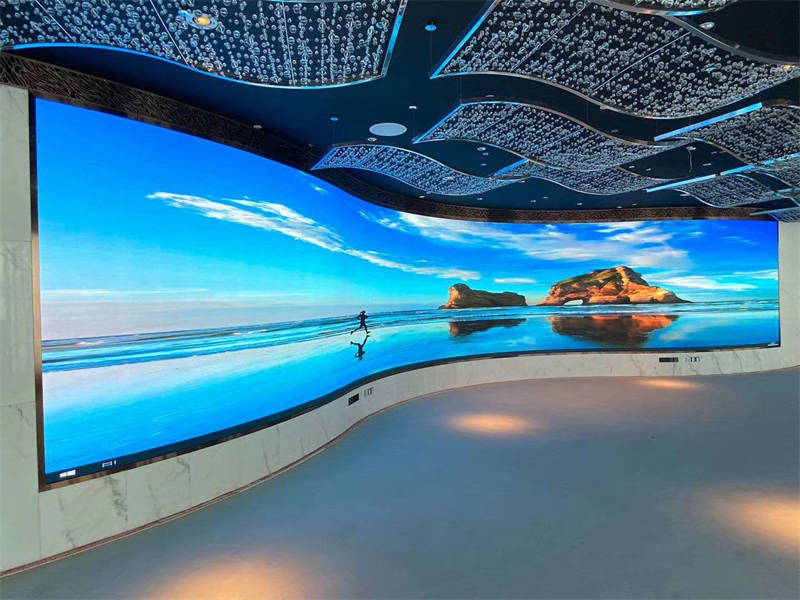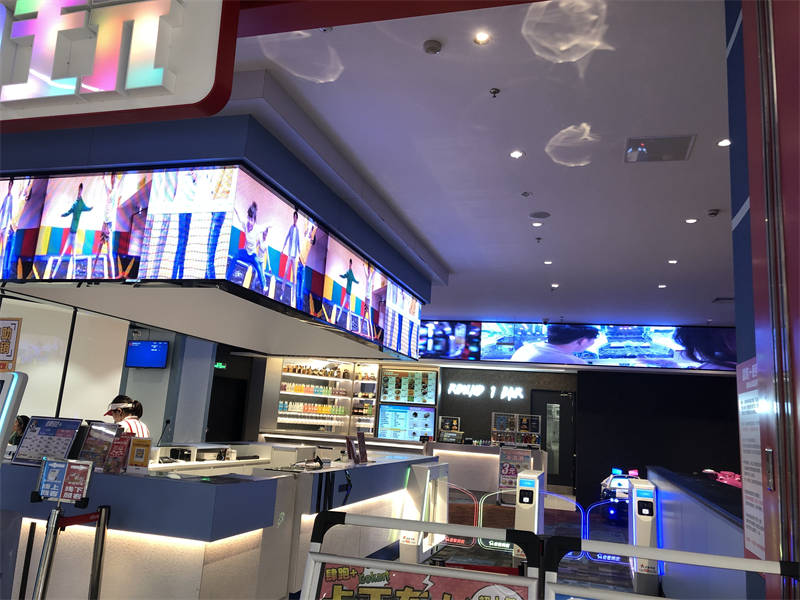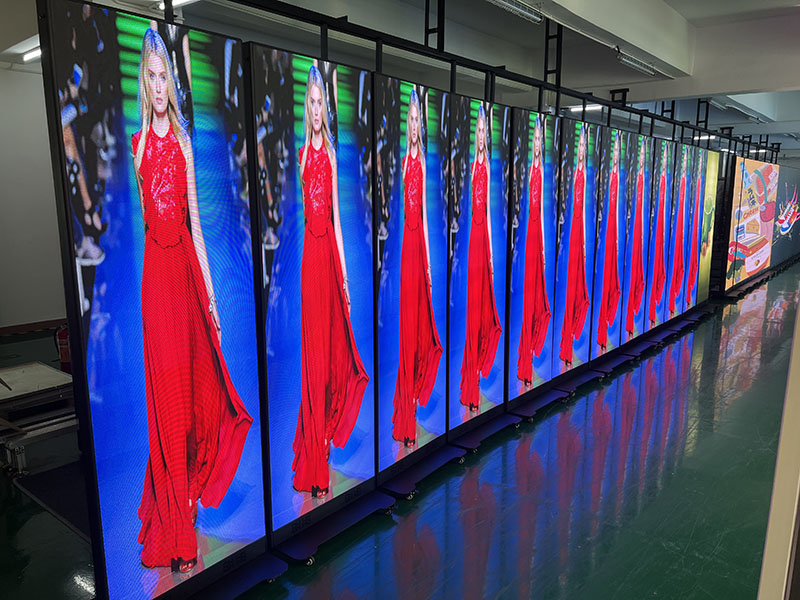LED display screen is an important information tool. Its technical parameters not only affect the display effect, but also directly affect the user’s viewing experience and the application scenario. If you are looking for an LED display screen, you should first understand some key parameters.
Table of Contents
TogglePhysical indicators
Pixel Pitch
Pixel pitch, also known as dot pitch, refers to the distance between the centers of two adjacent pixels, usually in millimeters (mm). This parameter directly affects the resolution and viewing distance of the LED display screen.
The smaller the dot pitch, the more pixels can be accommodated in the same area, thereby improving the resolution and making the image more delicate. However, too small a dot pitch also increases unnecessary costs.
For example: If the pixel pitch of an LED display screen is P1.6 (ie 1.6mm), it means that the center distance between adjacent pixels is 1.6 mm. For this type screen, if you want to know its best viewing distance, you can estimate it through a simple formula:
P (dot pitch) × 1700
Therefore, a P1.6 LED screen is suitable for viewing beyond 2.72 meters (about 2.7 meters).
Density
Density refers to the number of pixels per unit area of the LED screen, and the unit is usually dots/square meter (dots/m²). It is inversely proportional to the dot pitch, and the calculation formula is: density = 1000 / dot pitch (mm)*2.
For example: Taking the P1.6 LED display screen as an example, its density is about 1000/1.6=625*625=390625 dots/m². Under the same plane size, higher density LED displays can present clearer and more delicate images. They are more suitable for high-precision display, such as conference rooms, command centers, etc.
Level Up Degree
Level Up Degree is an important indicator to measure the flatness of the surface of the LED display screen. It reflects the concave and convex deviation of the light-emitting diodes, pixels, LED display modules when they form the LED screen plane.
Poor flatness screens may have problems such as uneven color and image distortion when viewed, affecting the viewing effect. Therefore, when LED manufacturers produce LED screens, they need to strictly control the flatness of the LED screen.
Electrical Performance Indicators
Gray Scale
The number of brightness levels that can be distinguished from the darkest to the brightest in the same brightness level of the LED display. Grayscale is also known as color scale or gray scale, which refers to the degree of brightness. For digital display technology, grayscale is the determining factor of the number of displayed colors.
Generally speaking, the higher the grayscale, the richer the displayed colors, the more delicate the picture, and the easier it is to show rich details.
The grayscale level mainly depends on the number of bits of the A/D conversion of the system. Of course, the system’s video processing chip, memory and transmission system must provide support for the corresponding number of bits.
Generally, there are no grayscale, 8 levels, 16 levels, 32 levels, 64 levels, 128 levels, 256 levels, etc. The higher the grayscale level of the LED display, the richer the color and the more gorgeous the color;
Conversely, the displayed color is single and the change is simple. At present, low-end LED display screens mainly use 8-bit processing systems- 256 (28) levels of grayscale. Simply put, there are 256 brightness changes from black to white. Using the three primary colors of RGB, 256×256×256=16777216 colors.
High-end LED displays mainly use a 10-bit processing system- 1024 grayscale levels, and the three primary colors of RGB can form 1.07 billion colors.
Refresh Frame Frequency
The frame frequency refers to the frequency at which the LED display screen information is updated, usually in frames per second (fps). It determines the smoothness of image changes.
Generally speaking, the higher the frame frequency, the better the continuity of image changes, and the less likely it is to freeze or skip frames when watching. However, too high a frame frequency will also increase the burden of data transmission and processing, and we need to weigh it.
For example: Common frame frequencies are 25Hz, 30Hz, 50Hz, 60Hz, etc. In high smoothness application, such as video playback, you need to choose a higher frame frequency to ensure the continuity of the picture.
Refresh Frequency
Refresh frequency refers to the number of times the LED display data is repeatedly displayed per second, usually in Hertz (Hz). It determines the stability of the image display.
Refresh frequency not only affects the stability of the image, but is also directly related to the service life of the display. Too low refresh frequency may cause the screen to age or damage prematurely. Therefore, when you choose an LED display, please determine the appropriate refresh frequency according to the needs of your specific application.
For example: Common refresh frequencies are 1920Hz, 3840Hz, 7680Hz, etc. High refresh rates LED Displays are more stable when displaying dynamic images, and can reduce the smear or blur caused by asynchronous screen refresh.
1920Hz vs 3840Hz vs 7680Hz Refresh Rate LED Screen: How to Choose?
Optical indicators
Luminance of LED Screen
Luminance of LED Screen refers to the average brightness of the LED display in the normal direction, usually in candela per square meter (cd/m²). It determines the visibility of the display in a strong light environment.
Too high or too low brightness will affect the viewing effect. Too high brightness may cause glare and visual fatigue, while too low brightness may cause the image to be dim and difficult to recognize.
For example:. The brightness of LED display screens for indoors is generally around 1000nit. Small-pitch LED screens are mainly used indoors and have rich colors, so the brightness should not be too high to prevent long-term viewing from damaging eyesight; the brightness of LED display screens for outdoors must exceed 6000nit to ensure clear display under strong sunlight; the brightness of semi-outdoor LED display screens is between 2500 and 5000 nit.
How to Calculate LED Screen Size, Resolution, Viewing Distance & Brightness
Viewing Angle
When the brightness in the horizontal and vertical directions is half of the brightness in the normal direction of the LED display screen, the angle between the viewing direction and the normal of the LED display screen is called the horizontal viewing angle and the vertical viewing angle. It is generally expressed as ± in degrees left and right and up and down.
If the horizontal viewing angle of a display screen is 120 degrees and the vertical viewing angle is 45 degrees, all viewers can enjoy the best viewing effect within this viewing range. Beyond this range, the audience will be able to see a visual effect that is 50% lower than the normal brightness. The larger the viewing angle of the LED display, the more audiences it has and the wider the coverage area, and vice versa.
The packaging method of the LED chip determines the viewing angle of the LED display. Among them, the viewing angle of the SMD LED lamp is better, and the horizontal viewing angle of the oval LED single lamp is better. The viewing angle is inversely proportional to the brightness.
Life of LED Screen
The life of the display refers to the length of time that the LED display can continue to work under normal conditions use, usually expressed in hours (h).
LED display life directly affects its use cost and maintenance cost. Therefore, when you choose an LED display, please give priority to high-quality LED screens from well-known brands such as SightLED.
For example: As a semiconductor device, the theoretical life of LED can reach more than 100,000 hours. However, in actual applications, due to factors such as the use environment and operation method, the actual life of the display may vary.
Other important parameters
Unit Board Specification
The unit board specification refers to the LED module size, usually expressed as length × width, and the unit is usually millimeters (mm). The unit board is one of the basic units that make up the LED display.
For example: Common unit board specifications include 48×244mm, 64×320mm, etc.
Contrast Ratio
Contrast refers to the ratio of the maximum brightness of the LED display screen to the background brightness under a certain ambient illumination. It reflects the ability of the display screen to distinguish between bright and dark parts.
Contrast is one of the important factors affecting the LED display effect. Appropriate contrast can enhance the layering and three-dimensional sense of the image, making the picture more realistic.
Color Temperature
Color temperature refers to the black body temperature value when the color emitted by the light source is the same as the color radiated by the black body at a certain temperature, and the unit is usually Kelvin (K).
Different color temperatures will directly affect the color atmosphere and visual effects of the LED screen. Lower color temperatures (such as 3000K) will present a warm color effect, which is suitable for creating a warm and comfortable atmosphere; while higher color temperatures (such as 9000K) will present a cool color effect, which is suitable for scenes that require brightness and freshness.
For example: The color temperature range of common LED display screens is between 3000K and 9500K, and the factory standard is generally around 6500K. You can adjust the color temperature according to specific needs to change the display effect.
Color Difference
Color difference refers to the color difference caused by factors such as materials and viewing angles when the LED display screen displays different colors. It is one of the important indicators to measure the color reproduction ability of the display screen.
Excessive color difference will cause problems such as image color distortion and blurred details, affecting the viewing effect. Therefore, during the production process, LED manufacturers need to strictly control the selection of materials and production processes to ensure that the color difference within a reasonable range.
Out-of-Control Point
Out-of-Control Point refers to the pixel point whose luminous state does not meet the control requirements. According to different forms of expression, it can be divided into blind spots (dead spots), constantly bright spots (dark spots) and flash spots.
Blind spots (dead spots):
Pixel points that are not bright when they should be lit are also called dead spots.
Example: If a pixel should be lit by a red light to display red, but it is not, then this point is a blind spot.
Constant bright spot (or dark spot):
A pixel that continues to light up when it should not be lit is called a constant bright spot, and vice versa (although it is not common, it exists in theory).
If a pixel is continuously lit with a red light when it needs to display black, it is a constant bright spot.
Flash point:
A pixel with an unstable light state, which is manifested as continuous flashing.
Example: The red light of a certain pixel flashes rapidly and cannot stably display the predetermined color.
Methods to solve the problem of pixel out-of-control on LED display
The main reason for the out-of-control of LED display pixels is usually the out-of-control of the LED light itself, which can be caused by poor quality or improper use of the LED. For example, in the common 2R1G1B or 1R1G1B pixel structure, as long as one of the color LED lights is out of control, the pixel is considered out of control.
Solution:
- Contact the service provider for professional repair.
- If the repair cost is high, you can contact the manufacturer to request a panel replacement.
- The specific situation needs to be inspected and maintained by professional maintenance personnel.
- Constant current drive and constant voltage drive
Constant current drive:
The current value specified when the constant output is designed within the working environment allowed by the driver IC.
Advantage: It solves the current difference problem caused by inconsistent internal resistance of the LED tube core.
Classification:
Static constant current drive: Suitable for outdoor display screens with high brightness.
Dynamic constant current drive: Suitable for indoor and semi-outdoor display screens, such as 1/2 scanning mode is often used for semi-outdoor screens.
Constant voltage drive:
The voltage value specified when the constant output is designed within the working environment allowed by the driver IC.
Current situation: With the development of technology, constant voltage drive is gradually replaced by constant current drive.
Conclusion:
In summary, we have introduced some key technical parameters of LED display screens in detail. They play an important role in the quality and price. If you are looking for a high-quality LED screen and you are still not very familiar with these parameters, please feel free to contact us. SightLED professional team will give you a good solution.







